
Mangifera is a genus of flowering plants in the cashew family, Anacardiaceae. It contains approximately 69 species, with the best-known being the Common Mango. The center of diversity is in subtropical and tropical South Asia and Southeast Asia, while the highest number of species occur in India. They are generally canopy trees in lowland rainforests, reaching a height of 30–40 m (98–131 ft).

Huperzia is a genus of lycophyte plants, sometimes known as the firmosses or fir clubmosses; the Flora of North America calls them gemma fir-mosses. This genus was originally included in the related genus Lycopodium, from which it differs in having undifferentiated sporangial leaves, and the sporangia not formed into apical cones. The common name firmoss, used for some of the north temperate species, refers to their superficial resemblance to branches of fir (Abies), a conifer. As of 2020, two very different circumscriptions of the genus were in use. In the Pteridophyte Phylogeny Group classification of 2016, Huperzia is one of three genera in the subfamily Huperzioideae of the family Lycopodiaceae. Most species in the subfamily are placed in the genus Phlegmariurus. Huperzia is left with about 25 species, although not all have been formally transferred to other genera. Other sources recognize only Huperzia, which then has about 340 species.
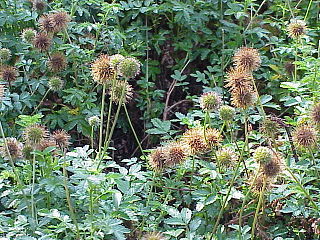
Acaena is a genus of about 60 species of mainly evergreen, creeping herbaceous perennial plants and subshrubs in the family Rosaceae, native mainly to the Southern Hemisphere, notably New Zealand, Australia and South America, but with a few species extending into the Northern Hemisphere, north to Hawaii and California.

Microsorum is a genus of ferns in the family Polypodiaceae, subfamily Microsoroideae, according to the Pteridophyte Phylogeny Group classification of 2016 (PPG I). The species are tropical. Like most ferns, they grow from rhizomes, rather than roots. The genus name is often misspelled "Microsorium" or "Microsoreum". It includes some species that are lithophytic rheophytes.

Bolbitis is a genus of ferns in the family Dryopteridaceae, subfamily Elaphoglossoideae, in the Pteridophyte Phylogeny Group classification of 2016.

Gymnosporia is an Old World genus of plants, that comprise suffrutices, shrubs and trees. It was formerly considered congeneric with Maytenus, but more recent investigations separated it based on the presence of achyblasts and spines, alternate leaves or fascicles of leaves, an inflorescence that forms a dichasium, mostly unisexual flowers, and fruit forming a dehiscent capsule, with an aril on the seed.

Hopea is a genus of plants in the family Dipterocarpaceae. The genus was named after John Hope, 1725–1786, the first Regius Keeper of the Royal Botanic Garden, Edinburgh. It contains some 113 species, distributed from Sri Lanka and southern India to southern China, and southward throughout Malesia to New Guinea. They are mainly main and subcanopy trees of lowland rainforest, but some species can become also emergent trees, such as Hopea nutans.

Lastreopsis, known as shieldfern, is a genus of ferns in the family Dryopteridaceae, subfamily Elaphoglossoideae, in the Pteridophyte Phylogeny Group classification of 2016.
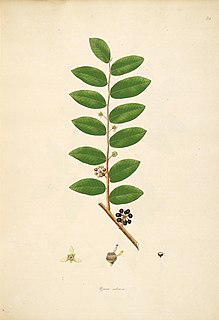
Polyalthia is a genus of flowering plants in the family Annonaceae. There are approximately 90 species distributed from Africa to Asia and the Pacific.

Tectaria is a genus of fern in the family Tectariaceae, according to the Pteridophyte Phylogeny Group classification of 2016. Halberd fern is a common name for species in this genus.

Dracontomelon is a genus of flowering plants in the family Anacardiaceae, growing mostly in SE Asia and the Pacific islands. The fruit may be used in local cuisine, especially as souring agents.

Ventilago is a genus of plants in the family Rhamnaceae. It includes about 40 species found in the tropics of South and SE Asia, Australasia, with one species each in Africa and Madagascar.

Microgramma is a genus of ferns in the family Polypodiaceae, subfamily Polypodioideae, according to the Pteridophyte Phylogeny Group classification of 2016 (PPG I). They are commonly known as vine ferns or snakeferns.
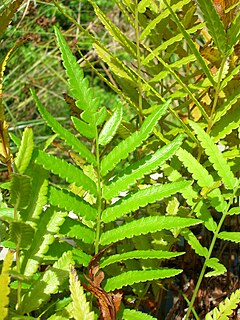
Cyclosorus is a genus of ferns in the family Thelypteridaceae, subfamily Thelypteridoideae, in the Pteridophyte Phylogeny Group classification of 2016. Other sources sink Cyclosorus into a very broadly defined genus Thelypteris, or expand the genus to include other genera which PPG I keeps separate. Thus the online Flora of China suggests there are about 250 species compared to the two species suggested in PPG I.
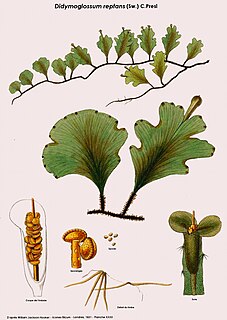
Didymoglossum is a tropical genus of ferns in the family Hymenophyllaceae. It comprises more than 30 epilithic or low-epiphytic species under two subgenera. The genus is accepted in the Pteridophyte Phylogeny Group classification of 2016, but not by some other sources which sink it into a broadly defined Trichomanes.
Drynarioideae is a subfamily of the fern family Polypodiaceae in the Pteridophyte Phylogeny Group classification of 2016 (PPG I). The subfamily is also treated as the tribe Drynarieae within a very broadly defined family Polypodiaceae sensu lato. In either case, it includes the previously separated tribe Selligueeae.
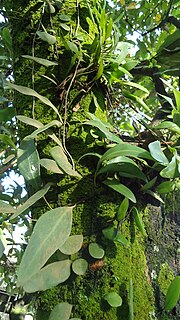
Pyrrosia is a genus of about 100 fern species in the polypod family, Polypodiaceae.

Macrothelypteris is a genus of ferns in the family Thelypteridaceae, subfamily Phegopteridoideae, in the Pteridophyte Phylogeny Group classification of 2016. The genus name means 'large Thelypteris'.

















